The Galapagos Islands- a Fabulous Bucket List Trip
Category: Adventurous retirement
September 13, 2017– The Galápagos Islands are at the top of many people’s bucket list destinations. This article will give you a taste of what that experience is like, based on your Editor’s recent trip, plus some tips and advice if you decide to go.
Where and what
The Galápagos are a volcanic archipelago of small islands in the Pacific Ocean about 600 miles west of Ecuador, which is near the top of south South America. They are most famous because of the role they played in Charles Darwin’s theories of evolution explained in his groundbreaking “Origin of the Species“. He visited the Islands in the early 1800’s, at a time when its only visitors were pirates and whalers. Its 18+ islands are now part of the country of Ecuador, and are protected as part of the Galápagos National Park.
In a nutshell, the Islands are a living laboratory of selective evolution. Formed by volcanoes (still active today), there were no living creatures until a few species arrived by air (birds, insects and plants) or water (reptiles, plants, fish, and a few mammals). Once they landed here and if they were able to reproduce, they have selectively evolved undisturbed by outside influences to become the species they are today. Many of these are endemic species, which means they exist nowhere else on the planet. In fact, some exist on only one or two of the Islands, although they have close relatives on neighboring Galápagos Islands. Getting a chance to meet these rare plants and animals in a spectacular island setting is the main reason why people come here.
What you will see
The most famous of the Galapagos creatures are its giant tortoises, which can live over 100 years and weigh hundreds of pounds. Although almost driven to extinction by sailors who captured them for their meat (they can live a year on a ship without eating or drinking), and by the cattle and goats introduced by man which ate their food supply, they are now making a comeback – thanks to many dedicated individuals and organizations. We saw many of them and they truly are impressive creatures.
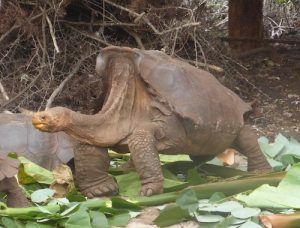
Iguanas are abundant, especially the marine iguanas, which are unique to the Islands. The latter are fantastic swimmers that feed on algae and clump together in huge groups on shoreline rocks and cliffs.
You will see countless sea lions and sea turtles, both on the shore and swimming in the water. The sea lions are extremely playful and curious; they will frolic near your boat and dive around you while you are swimming. If you are not careful you might step on one while walking in the beach. Like all animals here, they have no fear of humans.
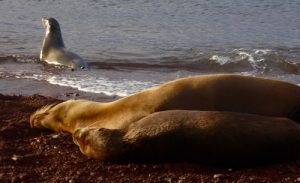
In the bird world there is much to see, from the world’s most northern penguins (which swim so fast they are hard to spot), to the Galapagos Hawk, to flightless cormorants. Darwin’s Finches are so-called because of the many different varieties that continue to evolve to meet local conditions. Even in one year the size and shape of their beaks can evolve because of the changing food supply. There are 3 distinct kinds of Boobies, including the amazing Blue Footed Boobies and Red Footed Boobies.
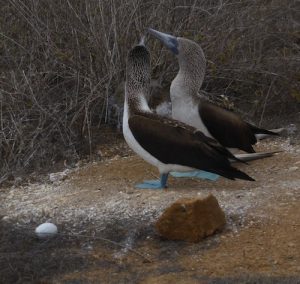
We were even lucky enough to have seen a volcanic eruption, which miraculously came alive just as we neared the western island of Isabela.

What you’ll do
From our 24 cabin ship, the National Geographic Islander, there were 2 or 3 excursions per day. We would get in the zodiac boats and either go to an island for a hike, ride along the cliffs and coves to see birds and marine life, or snorkel. No matter which option, there were always plenty of wildlife and plants to be seen. While snorkeling there were rivers of colorful fish, not to mention sea turtle traffic jams or curious sea lions. Otherwise we relaxed, listened to lectures by interesting naturalists, eat, or take a siesta!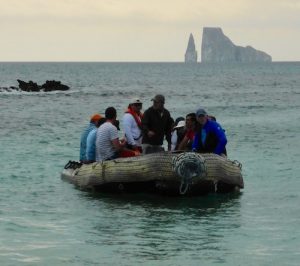
How to go
Most visitors here experience the islands in a small ship chartered by a tour operator. We used Lindbladt, who were great. Not only was the trip well run, but every detail including meeting us at the airports was taken care of. It is also possible to stay on land in one of the larger towns, such as Puerto Ayora and Puerto Baquerizo Moreno. From there you can arrange for boat trips and tours to the various islands on day trips. Regardless of how you go, access to the islands is tightly controlled. You must be accompanied by a naturalist/guide. Because the Islands are 600 miles from the mainland, you will get there by air from Ecuador (Guayaquil or Quito). Your budget and reviews by fellow travelers will help you find the right trip. Because the islands are remote and on so many people’s bucket lists, these trips are are generally expensive.
What to bring
Surprisingly, even though the Galapagos are on the Equator, it is very cool here in the dry season (North American summer). We didn’t believe it, and we should have. From May to November the Humboldt Current brings chilly waters from the Antarctic – the water temperature is often in the 60’s and the air in the 70s most of the time. Temps are much warmer in the wet season.
You will want some expedition clothes: long pants, shorts, and shirts with plenty of pockets and sun protection. A big hat will protect you from the equatorial sun, while a rain jacket and jacket or sweatshirt are also essential. You need binoculars to see the birds better. A very small backpack or fanny pack is useful.
Bring sunscreens and bug repellent; fortunately we did not need the latter.
Snorkeling
If you wear eye glasses bring a mask with a corrective insert (inexpensive at dive shops). The water was chilly when we were here in September so consider renting a full body wetsuit with feet and hood. Our expedition provided nice shortie wetsuits, but we were happy that we brought light body skins for extra warmth and sun protection. In fact we wore a double layer of wetsuits and that worked out well.
Photography
Serious photo buffs usually bring a high end model, but a compact or an iPhone will work too. Some of the best pictures on this trip were taken with an iPhone, often using its superb editing features. You can buy an iPhone attachment that makes taking distant photos easier. Consider taking a photography or iPhone class before you come. With a little training you can avoid snapshots, and end up with memorable photographs instead.
Other tips
If you going all the way to South America you might as well make the most of it. Consider adding a side trip to Machu Picchu, Columbia, or even one of the popular expatriate retirement towns Topretirements has reviewed in Ecuador, such as Vilcabamba or Cuenca.
This is an outdoors oriented trip. Most tours require that you have good mobility. Getting in and out of a zodiac boat at the ship and on a beach is not easy if are very overweight or lack mobility. Some hikes are steep and rocky (but others easy) but your expedition leader will let you know. Snorkeling requires you are at least a decent swimmer and are comfortable in the water.
If they offer, consider letting your tour operator make your air reservations. If, as happened to us, your plans change to a hurricane or other problem, they will help you with rebooking.
In conclusion
We are so glad we were fortunate enough to have experienced this bucket list trip. As always, please share your bucket list experiences and ideas in the comments section below
For further reading
Our Pinterest Bucket List (lots of cool photos)
What’s on Your Bucket List?
Bucketlist-Topretirements – The Complete List of Responses
Australia as a Bucket List Destination
Nostalgic Cars of the 50s and Sights of Cuba
An Antarctica Bucket List Adventure
Bagging the National Parks
Thrills and Nature in Costa Rica




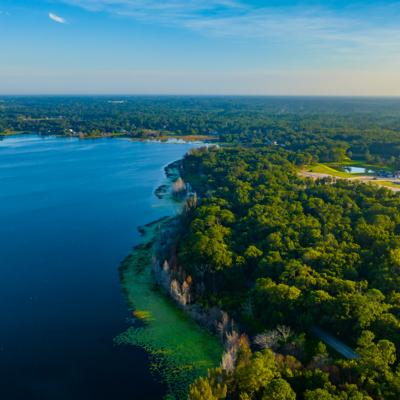
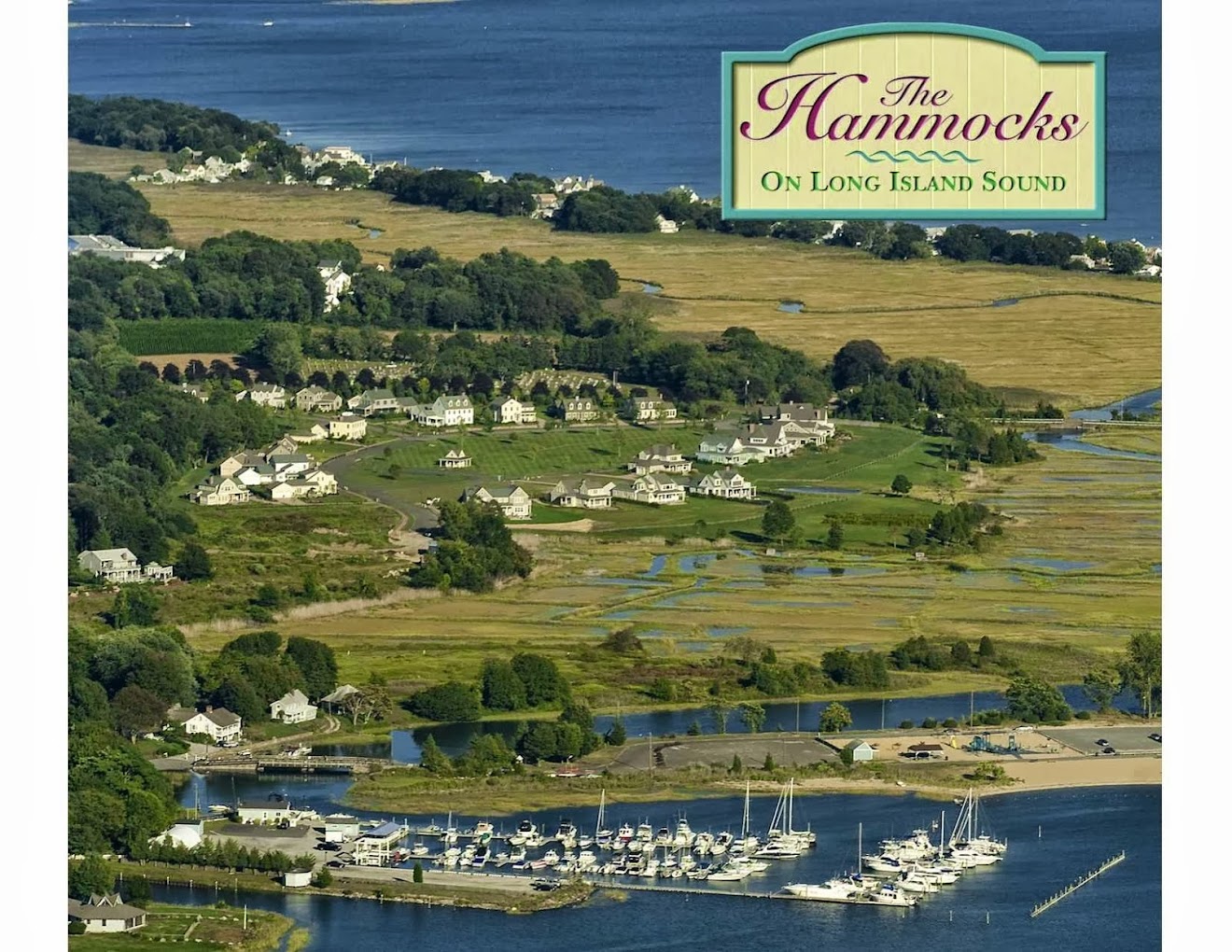

Comments on "The Galapagos Islands- a Fabulous Bucket List Trip"
Susan says:
My husband and I travel a lot but that is the first trip that I may skip. I am concerned about seasickness since we would be on a small boat. I would like to hear thoughts about that.
Mary says:
To Susan, I traveled for 5 days on the Santa Cruz II in late January 2016 and like you, worried about getting seasick. Well, the 90-passenger ship was very stable and the waters were very calm. I think all the islands break up the energy of the waves so that it is smooth sailing among the islands. It was a fantastic cruise!! Naturalists on board led groups of 12 or fewer passengers on walks or snorkeling twice a day and we could get up close to the animals and birds, after listening to a briefing session and agreeing to observe the ecological restrictions designed to protect the flora and fauna. The crew were absolutely great in assisting passengers on and off the small Zodiac boats so that we could all enjoy the shore excursions. I never experienced even a moment of queasiness. Bring seasickness medications if you are worried, but you might not need them!
Susan says:
Fabulous. Because of you I will get to go. What months would you suggest for calm seas
Lucy Burdette says:
Susan, I also get seasick and was on this trip with my husband. I think the dry season seas are a little rougher than the warm season (January to June is considered warm, I think.) So I had occasional days where I felt queasy, as did another passenger we got to know. But I took Dramamine regularly and found that worked pretty well. There are definitely advantages to going in the fall – it's much cooler and not at all buggy. All in all well worth the trouble for me!
Susan says:
How big was your boat, Lucy?. I researched and there are 2 bigger boats with the Santa Cruz II being 1. It was rated really well.
So thankful for this blog and Mary's response that made me do an about face on getting to go on the trip.
My husband isn't fond of heat or bugs and I have to have calm seas so what time of year to go will require further exploration.